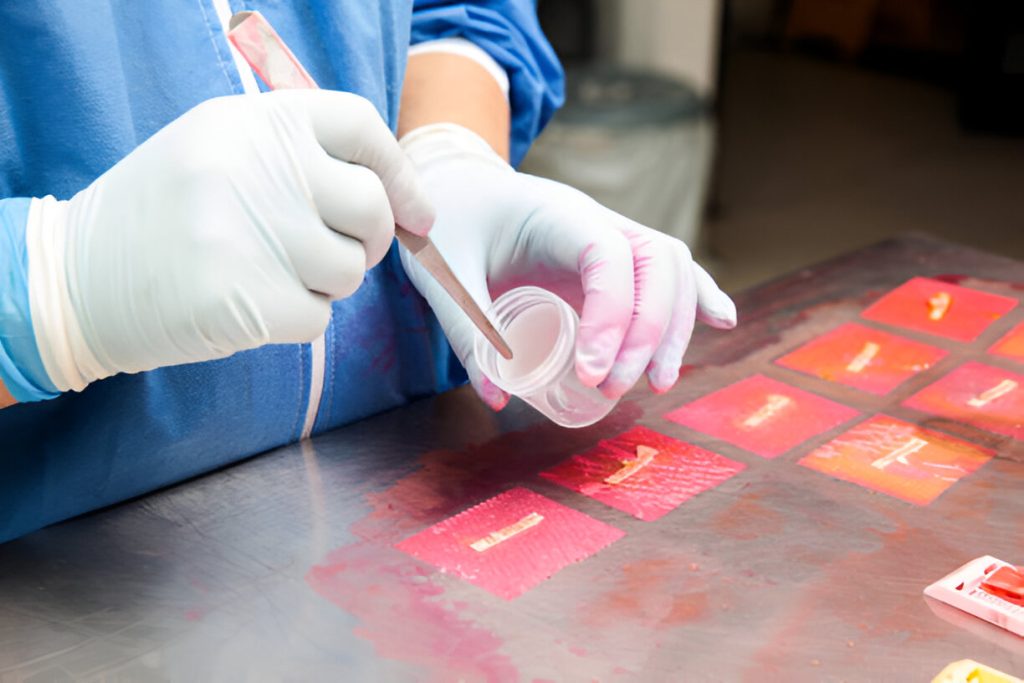Epithelial tissue protects the body and facilitates vital functions such as absorption and secretion. This tissue lines the surfaces of organs, cavities, and blood vessels, contributing to overall body health. Its ability to act as a barrier is crucial for maintaining homeostasis and defending against harmful agents.
In medical research, collecting epithelial tissue samples is critical to understanding diseases and disorders. These samples provide valuable insights into conditions like cancer, infections, and inflammation. Through detailed analysis, researchers can improve diagnostic accuracy and develop more effective treatment strategies.
Techniques for Analyzing Epithelium Samples
Once epithelial tissue specimens are collected and preserved, they undergo various analysis methods. These techniques collectively offer a comprehensive approach to studying tissue samples. The most common techniques include:
- Histological Examination: Tissue is sliced into thin sections and stained with dyes to make structures visible under a microscope, helping detect abnormalities like cancer, inflammation, or infection.
- Molecular Techniques: Methods like PCR and gene sequencing provide detailed insights into the genetic makeup, identifying mutations or disease markers.
- Immunohistochemistry: This technique uses antibodies to detect specific proteins, enhancing understanding of tissue behavior and pathology.
Methods of Collecting Epithelial Tissue Specimens
Collecting epithelial tissue specimens involves several techniques depending on the site of interest. Biopsy procedures, for example, are often used to remove tissue from organs or lesions. This method carefully extracts a small tissue sample, usually under local anesthesia. Another common technique is scraping, where cells are collected from epithelial layers using specialized tools, often seen in skin or mucosal membranes.
Swabs, brushings, or endoscopic procedures may be used to gather samples for specific internal organs. These methods ensure sufficient tissue is collected for accurate analysis while minimizing damage to the surrounding area. This precision is crucial for obtaining reliable results, particularly when diagnosing severe conditions such as cancer or infection.
How Epithelium Samples Are Preserved
Epithelial tissue specimens must be preserved after collection to maintain their integrity. These preservation techniques ensure that samples remain in optimal condition for analysis, preventing cellular breakdown that could compromise research results. Proper preservation is crucial for accurate and reliable findings in medical and scientific studies.
Common methods include:
- Freezing: Keeps cells viable for long-term storage in cryogenic conditions.
- Formalin Fixation: Preserves tissue structure and prevents bacterial or fungal growth.
The Impact on Medical Research
The role of epithelial tissue specimens in medical research and diagnostics cannot be overstated. These tissue samples help identify early signs of diseases, allowing for timely intervention and more effective treatments. By providing detailed information on tissues’ cellular and molecular makeup, scientists can make more informed decisions about treatment strategies, particularly for diseases like cancer.
Moreover, epithelial tissue research is essential in regenerative medicine, particularly tissue engineering and stem cell therapies. These studies provide insights into how damaged tissues can be repaired or replaced, offering hope for patients suffering from chronic conditions or injuries. The analysis of epithelial tissues has become an indispensable part of advancing healthcare and improving the quality of life for many individuals.
The accurate collection, preservation, and analysis of epithelial tissue samples are crucial for advancing medical research and improving diagnostic accuracy. These tissue samples provide valuable insights into the biology of diseases, helping develop more effective treatments. They are indispensable in studying various conditions, significantly contributing to scientific discoveries and enhancing patient care.

